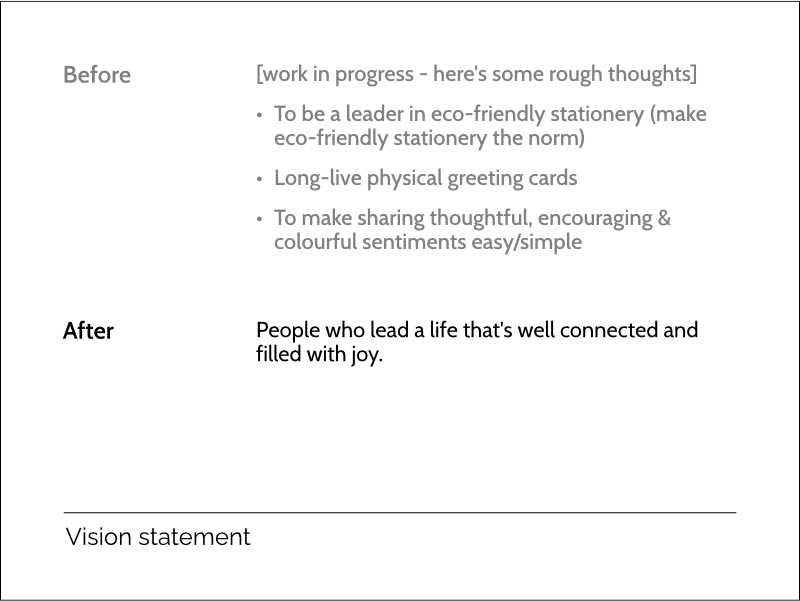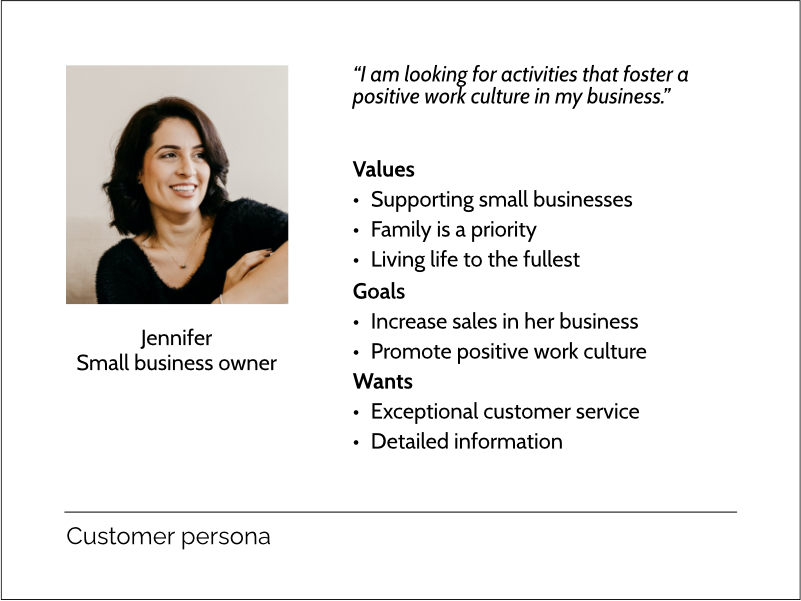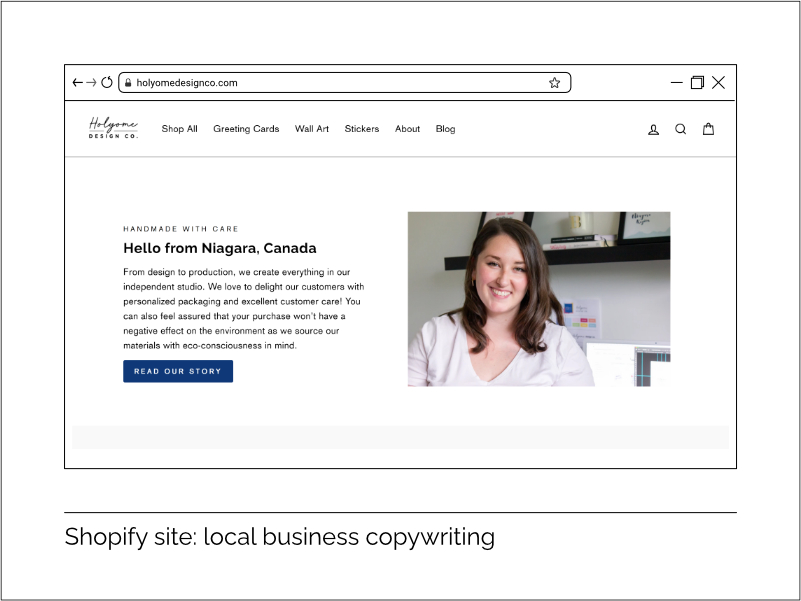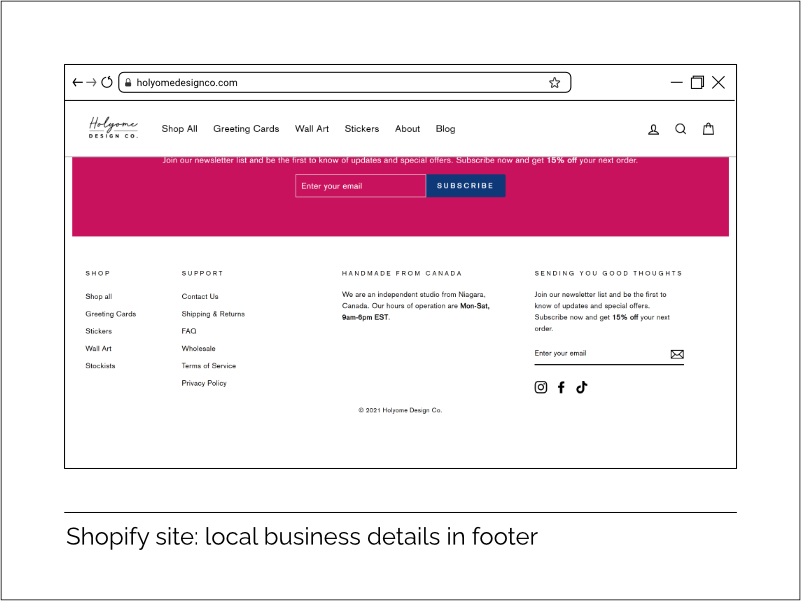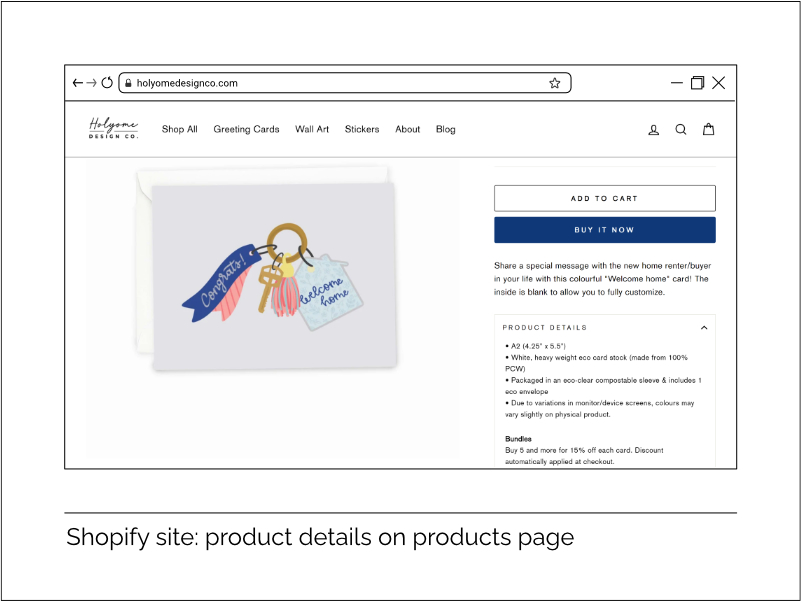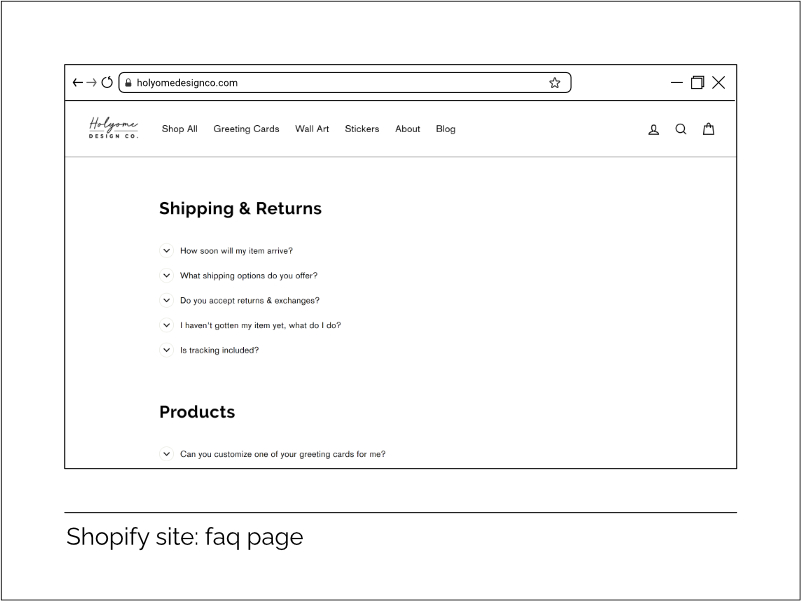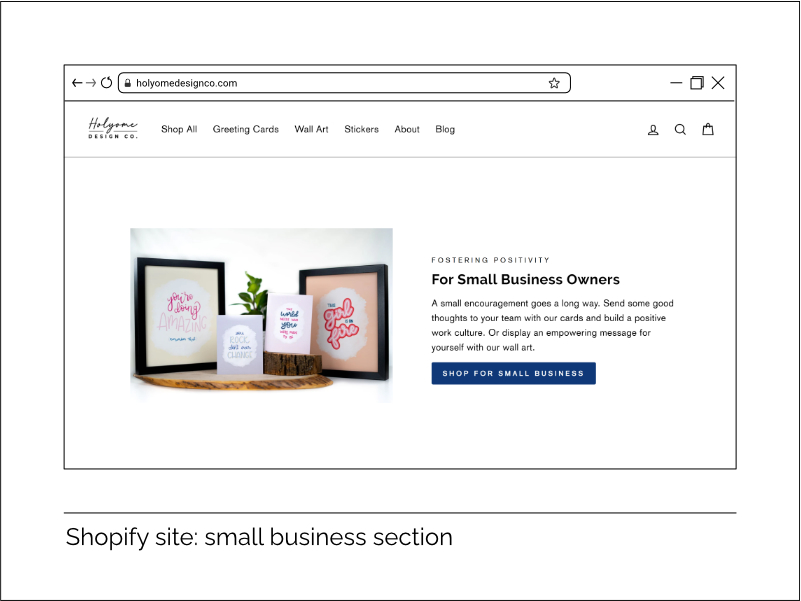Who is your ideal customer?
The first question I help my clients consider is: “who is your ideal customer”? This is an extremely complex question to answer. You’d be surprised to hear how many entrepreneurs struggle to articulate who their customers are. It’s nothing to be ashamed of because it’s a daunting problem to tackle. We need to put in the effort to understand customers because without them, there is no business.
When I asked Brittany who her customers were, here was her response:
“This is currently my biggest struggle — I’ve determined the below but I’m not sure that this is specific enough?
My primary customer is someone aged 25–45 who enjoys celebrating life’s milestones and values connection, thoughtfulness and encouraging/supporting those around them. They’re shoppers who are drawn to modern, colourful, and aesthetically pleasing stationery/paper goods. And finally they care about the environment and purchasing sustainable goods.”
Brittany listed demographic and psychographic traits. Here's a summary:
- Ages 25-45
- Enjoy celebrating life milestones
- Values connection
- Thoughtful and encouraging
- Drawn to a modern style
- Care about the environment
Her list is still very vague. To help us narrow down her ideal customer, we explored various customer segments who might have these traits:
- Teachers
- Realtors
- Florists
- Small business owners
- Eco-conscious buyers
We eventually narrowed down her ideal customer as small business owners from Niagara. I thought this was the most promising segment for her to target because of where she was from. Niagara is a tourist-based economy, and it is powered by small businesses in the area. Instead of trying to target a wide market, I encouraged her to target a smaller, but more promising market. This new customer segment is a lot easier to work with that her initial idea of who her customers were. A good test is how easy would it be for me to find a community of her customers. I would have a much easier time finding a community of small business owners from Niagara, than say “someone aged 25–45 who enjoys celebrating life’s milestones”.
As I worked with Brittany, I could sense she was uncomfortable with the idea of narrowing down.
“I do feel excited about this new direction, but I think this is just more of a mindset thing where it’s a hurdle I need to get over. I’m worrying that if I do go in this direction, I might be missing out on other things.”
The fear of narrowing down is common and expected. It’s scary because we fear that we are missing out on other opportunities. Which is true. By picking one area to focus on, we have to by default ignore other areas. But the reality is that when we chase two rabbits, we catch neither. So, when you are a young business starting out, focus on one area, and do it well. You can always expand on that idea into different areas later.
Why do customers buy from you?
Customers are constantly bombarded by ads that compete for their attention on what they should buy. It’s a saturated world in the eyes of the customer. So, if they have all this choice, why would they buy from you?
A good place to start is to look at data. I asked Brittany to talk to some of her past customers and gather some information on who they are and why they purchased from her. Talking directly to customers instead of sending out surveys is a great way to get data with a lot of depth. She reached out to two customers on Instagram.
Here are the top insights we learned from her two customers:
- Their purchases were usually occasion driven (baby shower, new job, birthdays). There was an exception to this, one customer is a small business owner and some of her purchases were for team development. Brittany collected this feedback after we decided on focusing on small business owners as her primary customer segment. We were in luck that this data was supporting our direction.
- They wanted to support local businesses. One of them mentioned Brittany’s shipping option of free delivery. This was good to learn, because it gave her a competitive edge over sellers outside her region.
- Finally, customers didn’t want something that was cookie cutter. They really wanted to gift unique items. This means that Brittany’s customers are the ones who would go the extra mile for something special and would be willing to pay more than what they would get at the local dollar store.
In addition to Brittany’s findings, I analyzed 15 recent Etsy reviews to learn what customers said about her brand.


We analyzed 15 Etsy reviews. Here are the top four themes.
At a high-level, the data explains why customers shop at Etsy, but not why they shopped from Brittany specifically. Aspects such as customer experience and shopping local all apply to shopping at local small businesses. The questions is: how is she different from similar sellers? I gave Brittany homework to analyze her competitors. Here’s one of the competitors we looked at:

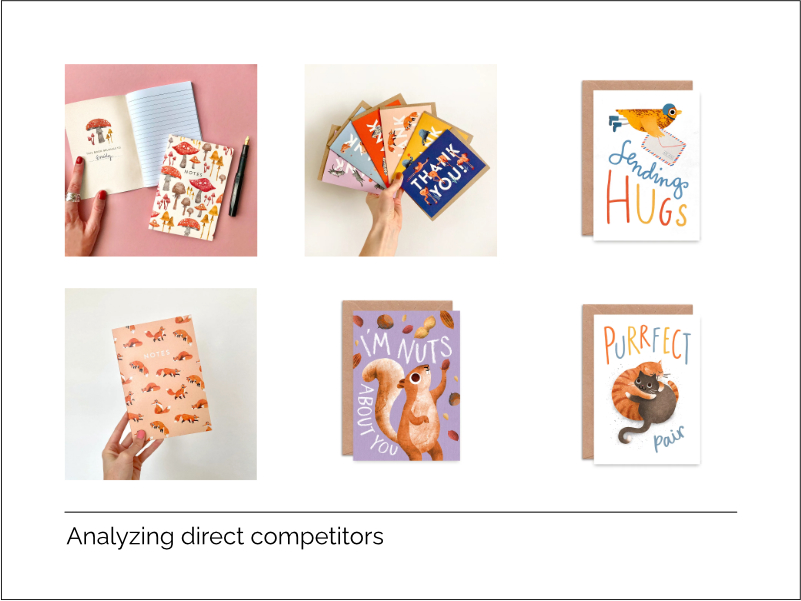
Emily Nash is a UK based illustrator. She sells greeting cards and notebooks featuring her whimsical and playful illustrations.
So, what makes Brittany different from Emily? The most obvious is design style. They both have a distinctive style and cater to different types of customers. Another differentiation is location. Brittany has better access to her local region than Emily, and by default can deliver faster and at lower rates. Both design and location are aspects out of one's control. What you can control is how you communicate your value offer, which is also known as a value proposition. This is where we go beyond the product and look at what the ultimate goal of the purchase is. Emily's value proposition is creating playful moments. What about Brittany?
When I asked Brittany what she thought her value proposition was, this was her response:
Offering a variety of stationery items that are not only high quality but eco-friendly as well. All greeting cards are made with 100% post consumer waste & packaging is compostable/recyclable to help offset any negative environmental aspects of sending and receiving handwritten cards. I also offer customized greeting cards & design, making sure that the customer is getting a product that’s perfect for them.
Brittany highlighted eco-friendly as part of her value offering. But, if we look at the data from our customer research, none of her customers highlighted eco-friendly as a reason for their purchase. In fact, if we think about customers who are eco-conscious, they wouldn’t buy greeting cards in the first place as they tend to consume less than an average person. So, we need to re-examine the value Brittany provides to her customers. (As a side note, being eco-friendly can be a strong value proposition depending on the industry, such as cosmetics and apparel).
To help Brittany develop her value proposition, we built a Customer Profile (which is part of the Value Proposition Canvas by Strategyzer). It helps us get into the customer’s shoes and understand their motivations for buying. The Customer Profile has three areas.

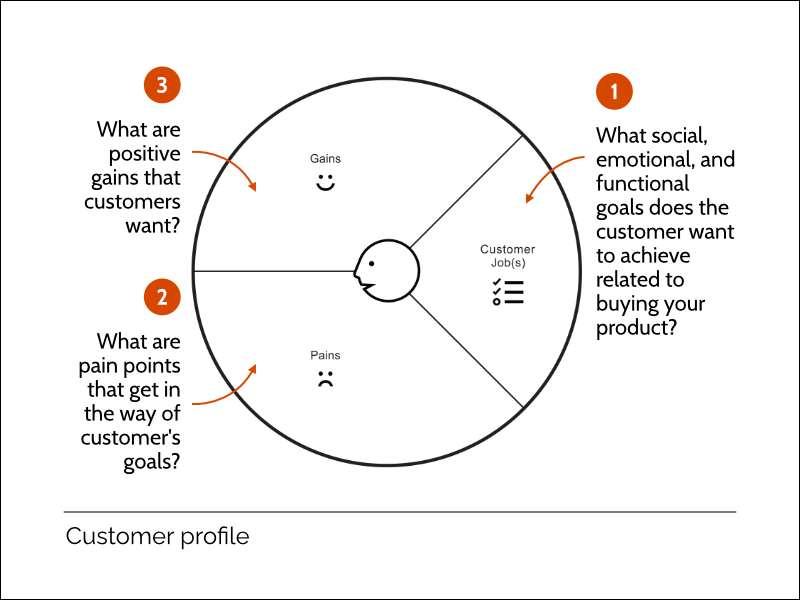
Customer profile that's part of the Value Proposition Canvas by Strategyzer.
To start, I asked Brittany what motivates a customer to purchase her greeting cards? I keep asking her "why" a couple of times to get her to think deeper until we get to somewhere interesting.
Why do customers purchase your greeting cards? Because they want to share sentiment in a tangible way. Why is this important? They want to show they acknowledge others and show they care. Why is that important? Because they want to build relationships in a meaningful way. A-ha!

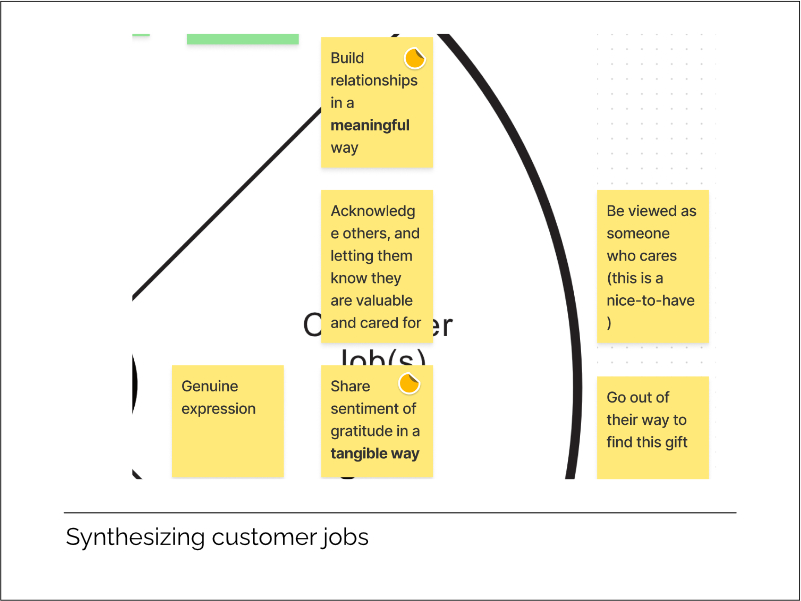
This was taken directly from the whiteboard developed with Brittany as we brainstormed customer jobs.
This is an interesting insight. Customers buy cards not because it’s just a card they can gift, but because it’s a way to build meaningful relationships. Beyond selling a product, Brittany’s products offer a way to help people build meaningful relationships. And just like that, we formulated Brittany’s value proposition.
So why should customers buy from Brittany’s shop? Because she can help small business owners build meaningful relationships. She can build on this idea in many innovative ways. What if she could build products that helped business owners form deeper client relationships? How about products for team development? Maybe an activity bundle with some prompt cards that fostered a positive work culture? The sky is the limit.
Why does your brand exist?
A brand is an identity, it should be consistent over time. Brands communicate messages to teach customers how to perceive the brand. Brittany didn’t have a very clear idea of her brand’s mission and vision. A clear brand helps steer the business and determines how a brand behaves. At the foundation of all brands are values. Values determine the purpose, which determines mission, which then creates the vision.

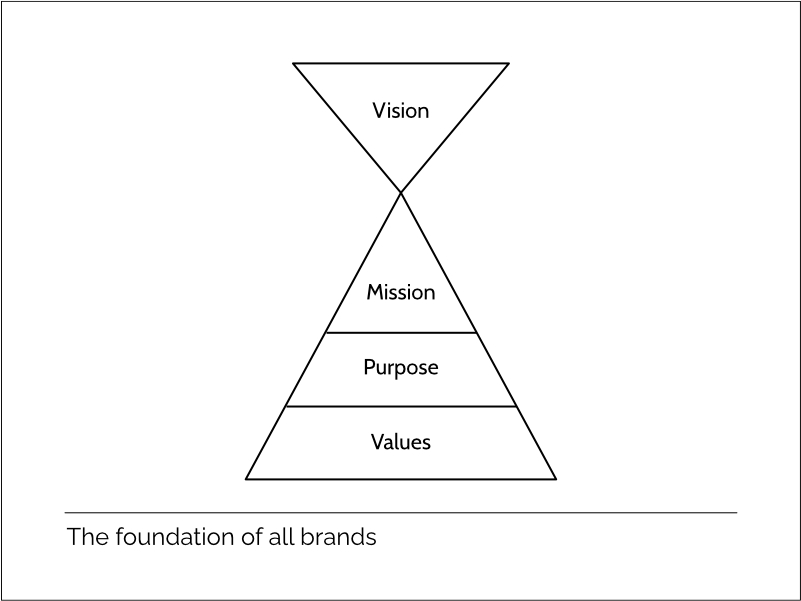
Before I worked with Brittany, I asked her to write out her vision, mission, purpose, and values. Below, we’ll look at how we transformed each of these. When I first met Brittany, I noticed how calm and soft-spoken she was. Looking at the values she wrote, I helped her distil it into two core values: caring for people and for the environment.

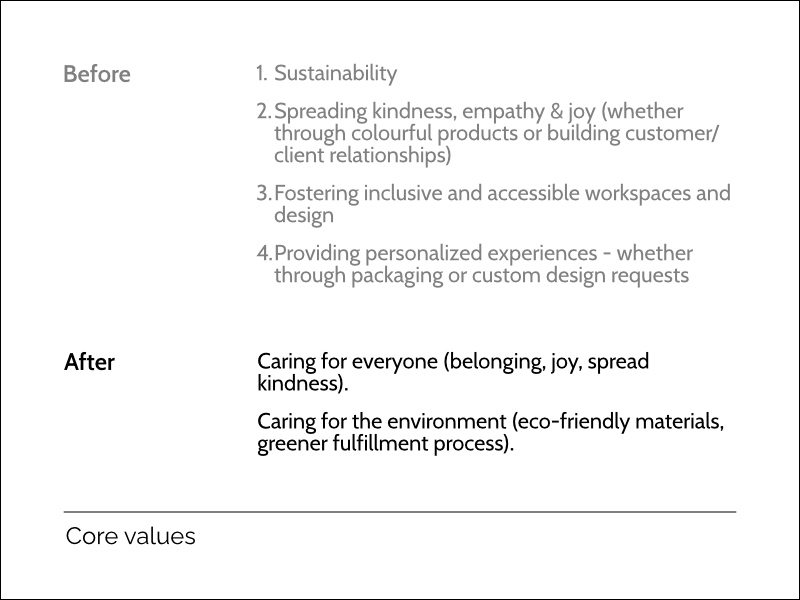
Before: The values Brittany came up with. After: The values we created together that distils her initial ideas.
The purpose statement she wrote was focused on bettering the world with thoughtful stationery. It had elements of the new core values we developed, but it didn’t reflect the new value proposition of helping her customers build meaningful relationships. The new purpose reflects this better.

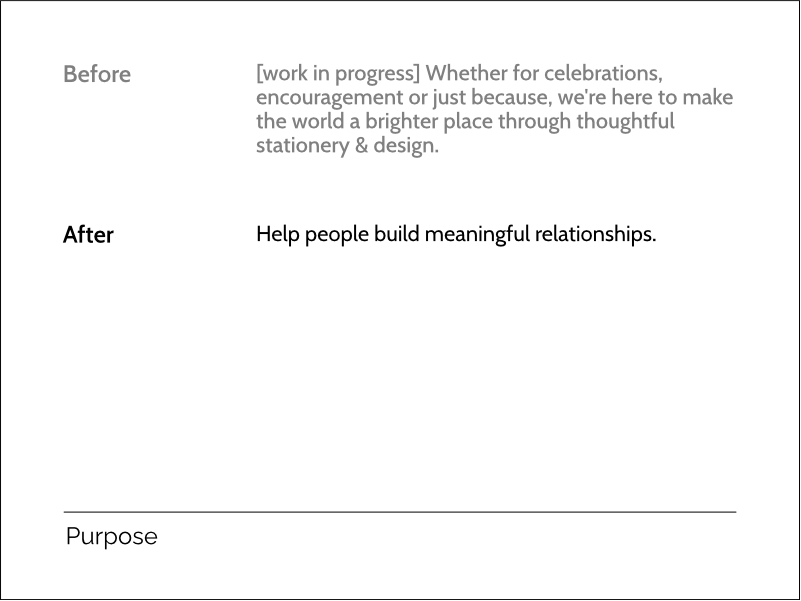
The mission statement lays out the “how” and is concrete in the steps to carry out a brand’s purpose. In the final mission statement, we agreed to exclude sustainability. I had several conversations with Brittany on this, I didn’t think it made sense for her to put her sustainability efforts as the protagonist in her brand, especially in her product category. Her Etsy store focuses on eco-friendly as her main offering, which I think isn’t why customers buy from her in the first place. To her customers, eco-friendly is a nice-to-have, not a deal breaker. Because her competitors could easily provide products that are also eco-friendly. In fact, the trend of being sustainable is becoming so normalized that it’s expected. I prefer A&W over McDonald’s because A&W has better burgers and their all-natural in-house root beer. A&W’s efforts in Canada to use packaging that’s compostable reinforces my love for them. However, once McDonald’s offers compostable packaging, I will still buy from A&W because they differentiate with higher quality food.


Finally, the vision expresses the future Brittany’s products could create. It encapsulates her values, purpose, and mission in a concise way.
We now have the heart of Brittany’s brand. What do we do with it? It becomes an important tool to help us create messages for her brand. Together, we created three key messages:
- Meaningful relationships: help people build meaningful relationships help them find the right words to express themselves
- Thoughtfulness: a way of life, being concerned for the wellbeing of her customers and the environment
- Customer experience: providing tremendous care and in the products and experience
These key messages would help us shape her Shopify website.










